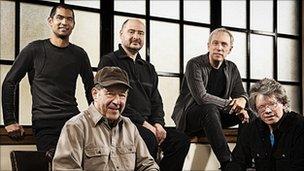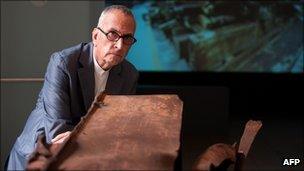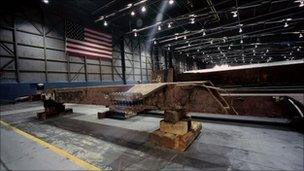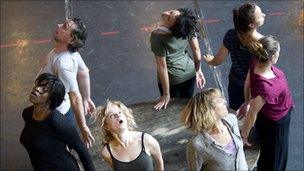9/11 anniversary observed by creative figures
- Published
The 10th anniversary of the 9/11 attacks is prompting many to reflect on how they have touched our lives.
Here, three creative artists from the worlds of music, photography and theatre reveal how they are commemorating those seismic events a decade on.
Steve Reich, composer
Like millions of people around the world, US composer Steve Reich knows exactly where he was when the planes hit the Twin Towers.

Reich (seated with cap) wrote the piece for chamber ensemble Kronos Quartet
"On 11 September I was in Vermont, 300 miles from our apartment in New York City," recalls the 74-year-old Pulitzer Prize winner.
"We got a call from my son. He said, 'I think they bombed the World Trade Center again.'
"We turned on the TV and saw the second plane hit, which was terrifying. My son was there with his daughter and his wife, four blocks away.
"I told him, 'Don't hang up, close all the windows and stay home until our next door neighbour comes back and gets you out of the city.'"
The events of 11 September 2001 "had a very personal, direct effect," says Reich.
"It was something that really impacted on my life."
Yet this was not something he felt he wanted to immediately address through his art. Indeed, it was eight years before Reich realised that he had "unfinished business".
The impetus was a request for a new piece of music for Kronos Quartet, the chamber ensemble Reich has collaborated with since 1989.
Reich's response was to fashion WTC 9/11 - a three-part composition that combines urgent, haunting strings with pre-recorded voices from people directly involved or affected by the tragedy.
Some of them belong to air traffic controllers from the North American Aerospace Defense Command (Norad), the first to notice that the aeroplanes were off course.
Others belong to workers of New York's Fire Department (FDNY), which lost many employees in the attacks.
The music also incorporates the songs and chants of the women who volunteered to keep vigil over the dead.
Due to difficulties involved in identifying some of the remains, it was a ritual they performed in shifts for seven months.
"This is not my fantasy or personal expression," says Reich. "I deal with 9/11 through the people who were the participants.
"That's the essential ingredient. By dealing with the documentary reality, it makes doing a piece completely and inarguably legitimate."
'Distraction'
First performed in March this year, WTC 9/11 - released on CD later this month - has not been without its critics.
The disc's original album cover was attacked for featuring a darkened photograph taken the moment before the second plane hit the second tower.
Some considered this exploitative, prompting record company Nonesuch to replace it with a different design.
Reich admits the cover was "a distraction" but suggests the majority of complaints had come from "people who had never heard the music".
"I think that right now we're going to talk about this piece until everyone's blue in the face," he says.
"It's quite understandable. But WTC 9/11 as a piece will live or die on the quality of the music.
"It's been played in London, New York, Los Angeles and North Carolina, and the reactions have been quite moving.
"I'm very happy people are taking the piece seriously, that they engage with it and it seems to move them."
WTC 9/11 is released by Nonesuch Records on 19 September. Reich's Mallet Quartet (2009) and Dance Patterns (2002) are also included.
Francesc Torres, photographer
After the towers fell, sifting through the mountains of rubble and debris at Ground Zero required a Herculean effort.

Torres (pictured) spent five weeks documenting the contents of Hangar 17
In the months and years that followed, the empty Hangar 17 at John F Kennedy International Airport became a makeshift home for objects salvaged from the site.
In the spring of 2009, Spanish photographer Francesc Torres was given rare access to the hangar to record the stored items.
A selection of his 1,500 photographs are on display at the Imperial War Museum in London, alongside a section of steel thought to come from the World Trade Center's North Tower.
"It was such an extraordinary sight I felt we had to document it," says the softly-spoken Torres. "It's a huge place and it was filled to the brim.
"There were things that were absolutely unbelievable. And then there were all these little things that were incredibly powerful."
The items Torres recorded ran the gamut from crushed fire engines and abandoned subway cars to a solitary pair of spectacles.
Bicycles still chained to railings are shown in one image, while another shows the remnants of a 360 foot (109 metre) broadcast antenna.

Steel beams and rusted girders were among the items stored in the cavernous space
Plastic reliefs of cartoon characters including Bugs Bunny and Tweetie Pie point to the Warner Bros store that once stood in the World Trade Center's underground mall.
And then there are what the photographer calls "composites" - compacted layers of what was once several floors of office space.
"It looks like volcanic magma, and within it you notice there are layers with different colourations and texture," explains the artist.
"You see clusters of what looks like black carbon that are compressed reams of office paper. If you touch it it cracks, but if you look closely you can still read what it says."
Largely left to his own devices, the only thing to stir Torres from his contemplation was the constant sound of aircraft taking off nearby.
'Emotional response'
"I was there alone with a plane flying over me every minute. I started to think, 'I'm in a building constructed to house a plane.
"'That was precisely the machine that was turned into a weapon that hit the towers, and now here's the result of that.'"
Some who lost loved ones in the tragedy may be unnerved by the idea of a stranger poring over their effects and putting them on display in a public setting.

Fire engines, taxi cabs and police cars damaged in the disaster occupied another area of the building
Torres feels it is the duty of the artist to deal with traumatic events, provided it is handled with sensitivity.
"There are many different ways of addressing this event, and they're all good and effective," he says.
"I don't think art is better, but it's good at certain things and it can explain things in a way that elicits an emotional response.
"Nietzsche said consciousness was essentially pictorial and it's true. An image can extract aspects that you wouldn't be able to using other material.
"9/11 is too big for art, no question, but that doesn't mean art can't do anything. It just has to find its place."
Memory Remains: 9/11 Artifacts at Hangar 17 continues at the Imperial War Museum, London until 26 February 2012. It will also be exhibited in New York, Barcelona and Madrid.
Rupert Goold, theatre director
Since 9/11, several playwrights have attempted to grapple with its cost, aftermath and significance.

Goold (centre) describes Headlong's latest work as "a kind of mosaic"
This year's Edinburgh Fringe saw a number of shows staged to mark the 10th anniversary, while the current production at London's Royal Court also touches on the terror attacks.
In The Faith Machine, external, a young couple make a fateful decision on the morning of 11 September 2001 that sees their lives progress in radically different directions.
Yet it would be misleading to describe Alexi Kaye Campbell's three-act drama as a "9/11 play".
Decade, the latest production from theatre company Headlong, external, has also provoked interest.
A site-specific, multi-authored piece incorporating contemporary dance and music, it is, in the words of director Rupert Goold, "a kind of mosaic" that will tackle 9/11 and its legacy head on.
"Part of the piece addresses healing and what wounds are left behind," says Goold, whose previous productions include a celebrated Macbeth with Sir Patrick Stewart and the award-winning Enron.
"But it wouldn't be theatre if it wasn't provocative, and inevitably that provocation may offend some people."
Staged in a disused building in London's St Katharine Docks, Decade comprises a collage of scenes penned by a team of writers, all working independently.
Their number includes Abi Morgan, creator of BBC drama The Hour, historian Simon Schama and US playwright John Logan, whose other current projects include working on the script for the next James Bond film.
"A lot of the writers felt they couldn't do justice to all those who died, the size of the event and what it meant politically," Goold explains.
"It's really hard to see the whole thing, so there was something about fractured slivers and snapshots that seemed appropriate."
The issue of what is and isn't appropriate is never far from the director's mind. One of the reasons, Goold says, why Decade has not been presented in a conventional theatre space.

More than a dozen writers contributed to the piece
"I felt the idea of rocking up on [London's] Shaftesbury Avenue at 7.30pm to see a 9/11 show was a bit tasteless.
"However, I think theatre and drama in general has always been one of the great mediums at helping us understand trauma," he adds.
"I hope we will stir the pot a bit in terms of what 9/11 might have meant to different people and allow people to reflect interestingly on that."
So will this be the "9/11 play" some people have been waiting for?
"God no," the director shudders. "We're in no way trying to be definitive.
"But at least we will grapple with it, and even if we fail it will inspire other people to look at it.
"All I can say is we're having a go."
Decade runs at St Katharine Docks in London until 15 October.